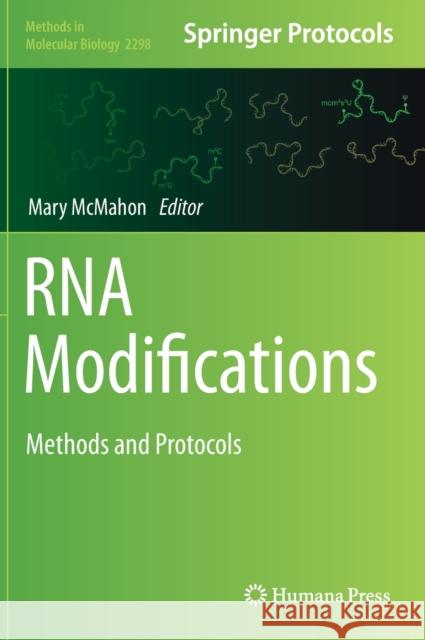RNA Modifications: Methods and Protocols » książka



RNA Modifications: Methods and Protocols
ISBN-13: 9781071613733 / Angielski / Twarda / 2021 / 427 str.
RNA Modifications: Methods and Protocols
ISBN-13: 9781071613733 / Angielski / Twarda / 2021 / 427 str.
(netto: 651,74 VAT: 5%)
Najniższa cena z 30 dni: 655,41
ok. 22 dni roboczych
Dostawa w 2026 r.
Darmowa dostawa!
Part I: Bioinformatic Tools to Study RNA Modifications
1. RNA Post-Transcriptional Modification Mapping Data Analysis Using RNA Framework
Ilaria Manfredonia and Danny Incarnato
2. An Informatics Pipeline for Profiling and Annotating RNA Modifications
Qi Liu, Xiaoqiang Lang, and Richard I. Gregory
Part II: Detecting RNA Modifications Using Nanopore Direct RNA Sequencing
3. EpiNano: Detection of m6A RNA Modifications Using Oxford Nanopore Direct RNA Sequencing
Huanle Liu, Oguzhan Begik, and Eva Maria Novoa
4. Adaptation of Human Ribosomal RNA for Nanopore Sequencing of Canonical and Modified Nucleotides
Miten Jain, Hugh E. Olsen, Mark Akeson, and Robin Abu-Shumays
Part III: Next-Generation Sequencing Approaches to Detect and Capture Modified RNAs
5. AlkAniline-Seq: A Highly Sensitive and Specific Method for Simultaneous Mapping of 7-Methyl-Guanosine (m7G) and 3-Methyl-Cytidine (m3C) in RNAs by High-Throughput Sequencing
Virginie Marchand, Lilia Ayadi, Valérie Bourguignon-Igel, Mark Helm, and Yuri Motorin
6. Transcriptome-Wide Detection of Internal N7-Methylguanosine
Li-Sheng Zhang, Chang Liu, and Chuan He
7. miCLIP-MaPseq Identifies Substrates of Radical SAM RNA Methylating Enzyme Using Mechanistic Crosslinking and Mismatch Profiling
Vanja Stojković, David E. Weinberg, and Danica Galonić Fujimori
8. Mapping RNA Modifications Using Photo-Crosslinking-Assisted Modification Sequencing
Bryan R. Cullen and Kevin Tsai
9. Quantitative and Single Nucleotide Resolution Profiling of RNA 5-Methylcytosine
Jun Li, Xingyu Wu, Trung Do, Vy Nguyen, Jing Zhao, Pei Qin Ng, Alice Burgess, Rakesh David, and Iain Searle
10. A Small RNA-Seq Protocol with Less Bias and Improved Capture of 2’-O-Methyl RNAs
Erwin L. van Dijk and Claude Thermes
Part IV: Assessing RNA Modifications Using qPCR- and Molecular Biology-Based Methods
11. Assessing 2'-O-Methylation of mRNA Using Quantitative PCR
Brittany A. Elliott and Christopher L. Holley
12. Relative Quantification of Residue Specific m6A RNA Methylation Using m6A-RT-QPCR
Ane Olazagoitia-Garmendia and Ainara Castellanos-Rubio
13. Monitoring the 5-Methoxycarbonylmethyl-2-Thiouridine (mcm5s2U) Modification Utilizing the Gamma-Toxin Endonuclease
Jenna M. Lentini and Dragony Fu
14. Analysis of Queuosine tRNA Modifications Using APB Northern Blot Assays
Cansu Cirzi and Francesca Tuorto
15. Detecting ADP-Ribosylation in RNA
Deeksha Munnur and Ivan Ahel
Part V: Mass Spectrometry- and NMR-Based Methods for RNA Modifications Analysis
16. Detecting Internal N7-Methylguanosine mRNA Modifications by Differential Enzymatic Digestion Coupled with Mass Spectrometry Analysis
Xue-Jiao You and Bi-Feng Yuan
17. A General LC-MS-Based Method for Direct and De Novo Sequencing of RNA Mixtures Containing Both Canonical and Modified Nucleotides
Ning Zhang, Shundi Shi, Xiaohong Yuan, Wenhao Ni, Xuanting Wang, Barney Yoo, Tony Z. Jia, Wenjia Li, and Shenglong Zhang
18. Quantification of Modified Nucleosides in the Context of NAIL-MS
Matthias Heiss, Kayla Borland, Yasemin Yoluç, and Stefanie Kellner
19. A Method to Monitor the Introduction of Post-Transcriptional Modifications in tRNAs with NMR Spectroscopy
Alexandre Gato, Marjorie Catala, Carine Tisné, and Pierre Barraud
Part VI: Approaches to Assess Kinetics, Determinants, and Functions of RNA Modifications
20. Effects of mRNA Modifications on Translation: An Overview
Bijoyita Roy
21. Assaying the Molecular Determinants and Kinetics of RNA Pseudouridylation by H/ACA snoRNAs and Stand-Alone Pseudouridine Synthases
Dominic P. Czekay, Sarah K. Schultz, and Ute Kothe
22. Investigating Pseudouridylation Mechanisms by High-Throughput In Vitro RNA Pseudouridylation and Sequencing
Nicole M. Martinez and Wendy V. Gilbert
23. Targeted RNA m6A Editing Using Engineered CRISPR-Cas9 Conjugates
Xiao-Min Liu and Shu-Bing Qian
This detailed book describes some of the most recent advances and up-to-date methodologies to detect, quantify, analyze, and elucidate the biological function of different types of RNA modifications. Importantly, the methodologies and tools described herein can be applied to a wide variety of organisms and can be used to address biological and clinical questions. Beginning with a section on bioinformatics tools, the collection continues with sections on detecting RNA modifications using Nanopore direct RNA sequencing, next-generation sequencing approaches, qPCR- and molecular biology-based methods, mass spectrometry- and NMR-based methods, as well as approaches to assess kinetics, determinants, and functions of RNA modifications. Written for the highly successful Methods in Molecular Biology series style, chapters include introduction to their respective topics, lists of the necessary materials and reagents, step-by-step, readily reproducible laboratory protocols, and tips on troubleshooting and avoiding known pitfalls.
1997-2025 DolnySlask.com Agencja Internetowa
KrainaKsiazek.PL - Księgarnia Internetowa









